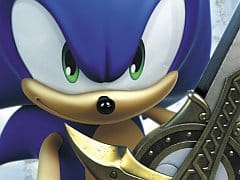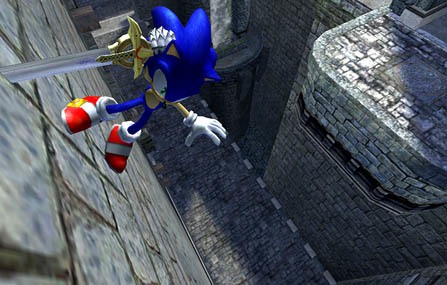You can trust VideoGamer. Our team of gaming experts spend hours testing and reviewing the latest games, to ensure you're reading the most comprehensive guide possible. Rest assured, all imagery and advice is unique and original. Check out how we test and review games here
The Sonic the Hedgehog series is generally split into two distinct eras. There’s the brilliant 16-bit era, where Sonic dazzled gamers with his insane speed, thrilling platform gameplay and great visuals, and then there’s the games released post Sonic Adventure. It’s fair to say that the recent games haven’t really impressed, and with this in mind we caught up with Sonic and the Black Knight director Tetsu Katano, armed with all the important questions – not just “Why can’t Sonic swim?”.
VideoGamer.com: Why did you want to make Sonic and the Black Knight on the Wii? This game is aimed at quite a young audience – is that Sonic’s home now?
Tetsu Katano: The reason we made it on the Wii was because it’s a direct descendant of Sonic and the Secret Rings and we wanted to make the most of internal resources in the dev team. In terms of the audience, you’re pretty much correct to say that children will be the core Sonic gamers. You have the animated Sonic series that is intended for younger kids, and I personally like to look at those kids as our most important audience. That said, we’re trying to make games which appeal to all generations.
VG: Sonic has been around for a long time now. Do you think he as a character has changed since, and if so how?
TK: Well, fundamentally Sonic hasn’t changed as a character, in my opinion. There’s always the speed, and in terms of his character he’s a man of silence. He doesn’t talk loud and he doesn’t express much. These core elements haven’t changed.
VG: What is the hardest thing about designing a Sonic game in 3D?
TK:That’s kind of hard to say, because there isn’t just one 3D game. If you look at Sonic Adventure and Sonic and the Secret Rings, they are quite different. Secret Rings was more of a racing game, whereas Adventure was more of an action adventure game. So it’s really hard to talk about 3D Sonic as a single game. With this one there’s a lot of sword action, so the challenge is bringing that to Sonic.
VG: As you said earlier, Sonic is all about speed. A lot of people didn’t like the Werehog in Unleashed, partly due to the fact that he was so slow. Do you think that character was a mistake, or should people be more open-minded?
TK:In principle, I think that the users are always right. They’re the ones paying the money and playing the games. If they don’t enjoy it, they’re not going to buy it. I don’t think that producing the Werehog was a mistake per se, but there were a lot of things we could have done better if we had more time and resources.
VG: What kind of things would you have done differently? Will we see the Werehog again?
TK:For the improvements, I can’t think of anything right now off the top of my head. If I think of any ideas then Sonic Unleashed 2 will be the time for that, so I don’t really have an answer for that. But you will see the Werehog again. I like Secret Rings very much, but when it came to making this title [Sonic and the Black Knight] we chose to do something different. All the good things about Secret Rings belong to that specific game. So in the same way, unless we’re going to make Sonic Unleashed 2 you might not see him again. But if we are going to make it, you might see him again. It’s a possibility.
VG: A lot of people think that the Wii has changed gaming in the West by opening it up to a wider audience. Do you agree?
TK:I definitely agree that the Wii has changed the gaming industry. As a game creator myself, I’m not really in a position to make a comfortable critique of the whole situation. But in my personal opinion Nintendo has a really good attitude to always try to do something new. That attitude was what went into making the Wii such a phenomenon throughout the world. I think very highly of them.
Sonic and the Black Knight is due for release exclusively on Wii in March.

/https://oimg.videogamer.com/images/83fe/sonic_and_the_black_knight_72.jpg)






